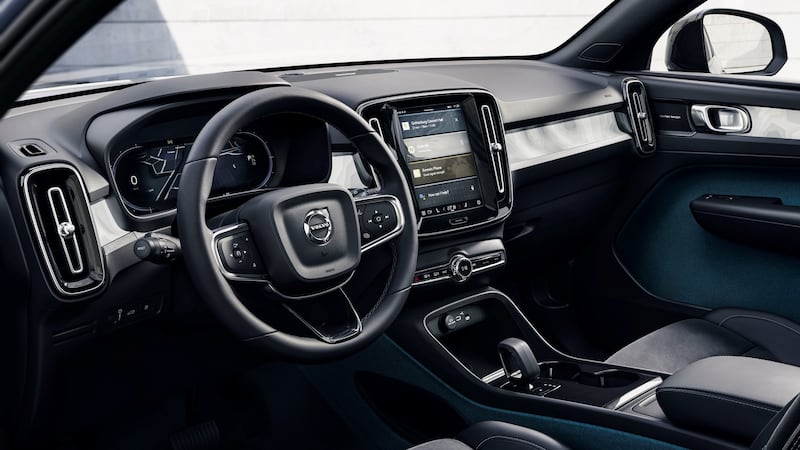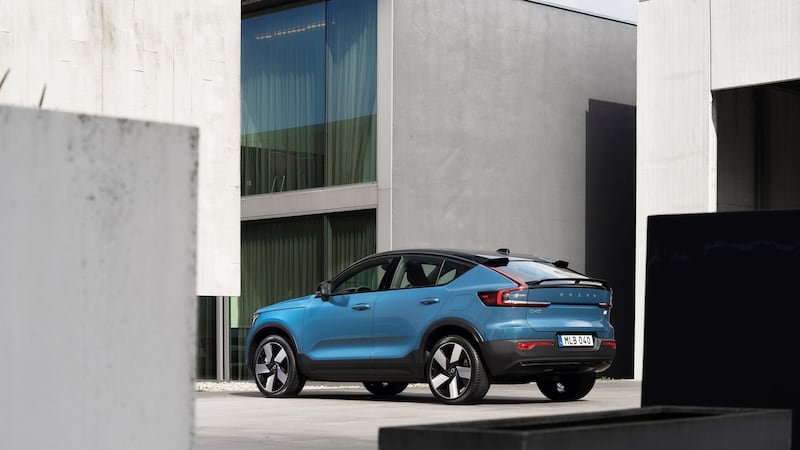As the woman in When Harry Met Sally puts it, sometimes you just know, the way you know with a good melon.
First impressions, gut feeling – whatever you want to call it – in this game of reviewing cars, you generally know pretty soon after sitting into a car and driving it for a short time whether or not you basically like it. Nuance, detail, pros and cons come later, but for the most part your initial feeling will stick with you.
Not with this, the Volvo C40. In fact, even as I start to type these words, it’s a car about which my feelings remain unclear. So, forgive me if I take us on a rambling stroll through my analytical circuits – but hey, writing is therapy, so this may benefit both of us.
The C40 is that most modern of motoring confections, the SUV coupe. This is, generally, a breed of car I intensely dislike. I regard myself as a basically sensible person, so the idea of taking a large, practical SUV and making it less practical in the pursuit of questionable aesthetic goals is anathema to me. Don’t get me started on the BMW X6.
Rather handsome
However, even I have to admit that the C40 is a rather handsome car. In the photos, that truncated and rounded roofline looks a bit odd, but in person, where you can see the careful 3D detailing around the rear lights and the roof spoiler, it kind of works. I still think the chunky Lego brick that is the taller, more rectilinear XC40, on which the C40 is based, looks nicer, but I’d not be in any sense ashamed to have this car on my driveway.
It’s also a car possessed of truly excellent performance. Not for Volvo a single 204hp electric motor, oh no – the Swedes have put a pair of 200hp electric motors into the C40, at least in this Recharge Twin model. That makes for a total 408hp, which is lots. Hammer the accelerator pedal and this chunky, medium-sized SUV (it’s not a coupe, can we be clear on that?) will hit 100km/h from rest in 4.7 seconds. It’s not so long since one needed a BMW M3 to achieve acceleration such as that.
So it looks good and it’s quick. Should be a slam-dunk winner, right?
Is it, though? Like I said, those first impressions count for a lot, and when you pop open the driver’s door and sit into the C40, it’s hard not to feel a little disappointed. The cabin is well-made, and knowing Volvo’s reputation for such things, I’d expect it to be robust in long-term use, but it just looks and feels a bit cheap.

Price tag
Cheap especially in view of the fact that our test car clocked in with a price tag of €68,950. When you've finished spitting out your tea at that fact, can I suggest that you don't take another mouthful before I mention that the seats are upholstered in plain, black cloth. Not leather. Not pleather. Not even the lovely, soft-touch, wool-and-recycled-plastic fabric that Land Rover uses as a leather alternative. Just plain old black cloth that looks as if it comes from the section of the Mercedes catalogue dedicated to taxi drivers.
It’s not all bad in there. The main digital instruments look good, and the map on the dashboard is rather lovely. I don’t mean the satellite navigation, I mean the map of Gothenburg, Volvo’s home town, embossed in soft-touch rubber into the dashboard and door tops. It’s a really sweet little touch, and along with the Swedish flag label on the edge of the driver’s seat, a reminder of Volvo’s oft-charming Nordic iconoclasm.
Less lovely is the touchscreen. A nine-inch screen is fine these days, but for the less money, Skoda will offer you a 13-inch screen in the more affordable Enyaq.
There are neat expandable sections at the bottom of the screen which take care of heating and air conditioning, and the volcanically-hot heated seats and steering wheel (rear-seat passengers get heated seats too) but Volvo’s new Google-based infotainment system looks a bit ... plain.
The steering feels meaty and well-balanced, and the ride quality is firm, but nicely damped
There seems to be vast areas of unpopulated screen when you open up the menu, almost as if it's been released before it was fully developed. It is nice that you can sign in with your Google ID and get all your saved map searches and so on, although the privacy implications probably don't really bear thinking about if you fancy a good night's sleep tonight. Built-in Spotify is also welcome, but compared to Volvo's old Sensus infotainment system, it all feels a bit underpopulated and underfeatured.
Then you start driving it. At first, the C40 feels good – it’s certainly fast, almost discombobulatingly so at times, thanks to a Merc AMG-like 660Nm of torque – and it’s quite good to drive, too. The steering feels meaty and well-balanced, and the ride quality is firm, but nicely damped. It’s not a driver’s machine, by any means, but it steers and turns well enough to be basically enjoyable.
But then you notice that the range depletes way, way too fast. With those two motors sucking on the battery all the time, we averaged 26kWh/100km during our time with the C40, which chopped the range available from the 75kWh (net) battery to less than 300km in real-world conditions.
Against Volvo’s claim of 420km, that’s not great, but against far more solid real-world ranges from direct competitors such as that Skoda Enyaq or Hyundai’s brilliant Ioniq 5, it’s really lacking. That’s without even mentioning Tesla.

Upended
Volvo is rolling out a version of the C40 that uses a single 229hp motor, a 69kWh battery, and a range of 434km which may work out as a more usable vehicle overall. But it will still cost €53,750. For that money, you could have a Hyundai Ioniq 5 with the big 73kWh battery, a 500-odd-km range, and in ritzy Premium Plus trim. Okay, so Hyundai's not a premium brand and Volvo is, but that game is being somewhat upended by the switch to electric motoring.
Of course, the Volvo will be exceptionally safe. The C40 is positively stuffed with electronic safety aids, and being a Volvo it will be physically built like a brick outhouse so if the very worst should happen, I have no doubt at all that it will be the best place to be. There is an undeniably reassuring feeling from driving home on a cold, wet night in a Volvo.
Hmm. We’re more than 1,000 words in and I still don’t quite know how I feel about the C40. Okay, here goes. The Volvo C40 is, in many ways, a deeply impressive vehicle that underscores traditional Volvo values – safety, space, practicality, quality, comfort – with some cutting-edge infotainment tech and electric performance that can be shatteringly fast at times. But – and it’s a big but – it’s too expensive relative to some exceptionally talented rivals, and it needs more usable real-world range. Sometimes you just know with a good melon, but occasionally it takes longer to figure a new Volvo out.
Lowdown: Volvo C40 Recharge Twin Pro AWD
Power: 75kWh (net) battery and 300kW twin-motor electric powertrain developing 408hp and 660Nm of torque, driving a single-speed automatic transmission with four-wheel drive.
CO2 emissions (annual motor tax): 0g/km (€120).
Electric consumption: 18.0kWh/100km.
Range: 420km (WLTP)
0-100km/h: 4.7sec.
Price: €68,950 as tested; C40 starts at €53,750.
Our rating: 2/5.
Verdict: Ludicrous speed, but too pricey for what it offers.












